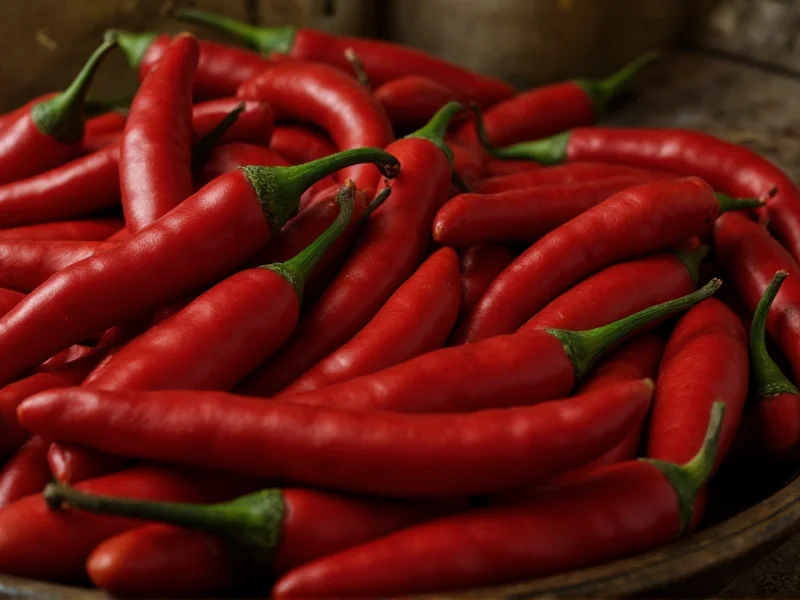Ancho chilies represent one of the most popular dried peppers in Mexican cooking, yet many home cooks remain uncertain about their actual heat level. Understanding where these distinctive heart-shaped peppers fall on the Scoville scale is essential for creating balanced dishes without unexpected spice surprises.
Understanding the Scoville Heat Scale
The Scoville scale, developed by pharmacist Wilbur Scoville in 1912, measures the pungency or 'heat' of chili peppers and other spicy foods. This measurement is expressed in Scoville Heat Units (SHU), which indicate the concentration of capsaicin—the chemical compound responsible for the burning sensation we perceive as 'heat.'
Originally determined through human taste testing, modern laboratories now use high-performance liquid chromatography to measure capsaicinoids precisely. The scale ranges from zero (no heat, like bell peppers) to over 2 million SHU for the hottest peppers like the Carolina Reaper.
Ancho Chili: Mild Heat with Complex Flavor
Ancho chilies are simply dried poblano peppers, harvested at full maturity and then sun-dried. This drying process concentrates their flavors while maintaining their relatively mild heat profile. The 1,000-2,000 SHU rating places anchos significantly below many common peppers:
| Pepper Type | Scoville Heat Units (SHU) | Heat Level |
|---|---|---|
| Ancho Chili | 1,000-2,000 | Mild |
| Bell Pepper | 0 | None |
| Poblano (fresh) | 1,000-2,000 | Mild |
| Jalapeño | 2,500-8,000 | Medium |
| Serrano | 10,000-23,000 | Hot |
| Habanero | 100,000-350,000 | Very Hot |
Factors Influencing Ancho Chili Heat
Several variables can affect the actual heat level you experience when using ancho chilies:
- Growing conditions: Soil composition, climate, and water availability impact capsaicin production
- Drying process: Sun-dried versus oven-dried can slightly alter heat perception
- Seed and membrane content: Removing seeds and white membranes significantly reduces heat
- Age of the pepper: Older dried peppers gradually lose potency over time
Interestingly, the drying process that creates anchos from fresh poblanos doesn't substantially increase their heat level. Unlike some peppers that become significantly hotter when dried, anchos maintain a similar SHU range to their fresh counterparts.
Culinary Applications of Ancho Chilies
The mild heat profile of ancho chilies makes them exceptionally versatile in cooking. Their heat serves as a subtle background note rather than a dominant flavor. Chefs appreciate anchos for their complex flavor profile that includes:
- Notes of dried fruit (particularly raisins and figs)
- Earthy, tobacco-like undertones
- Subtle hints of coffee and chocolate
- A gentle warmth that builds gradually
When rehydrated and blended, ancho chilies form the foundation of many traditional Mexican mole sauces. Their mild heat allows other complex flavors to shine through without overwhelming the palate. For those sensitive to spice, anchos provide authentic Mexican flavor without excessive heat.
Ancho vs. Similar Peppers: Understanding the Differences
Many cooks confuse anchos with other dried Mexican peppers. Here's how they compare:
- Ancho vs. Pasilla: Pasilla peppers (dried chilaca) run slightly hotter at 1,000-2,500 SHU with more pronounced berry notes
- Ancho vs. Mulato: Mulatos (dried poblano harvested later) have similar heat (900-1,800 SHU) but richer, smokier flavor
- Ancho vs. Guajillo: Guajillos (dried mirasol) are moderately hotter (2,500-5,000 SHU) with tangy, floral notes
Understanding these subtle differences in the ancho chili heat scale helps cooks make informed substitutions when creating authentic Mexican dishes.
Substituting Ancho Chilies Based on Heat
If you need to replace anchos in a recipe, consider these alternatives based on heat level:
- For similar mild heat: Use fresh poblanos (roasted and peeled) or dried pasilla peppers
- For slightly more heat: Guajillo peppers provide additional warmth while maintaining fruitiness
- For no heat: Sweet paprika offers similar color without any spiciness
- For convenience: Ancho chili powder maintains the flavor profile in powdered form
Remember that when substituting, you'll want to adjust quantities based on the relative heat levels. One dried ancho typically equals about 1-2 teaspoons of ancho chili powder, depending on the brand's concentration.
Practical Tips for Working with Ancho Chilies
Maximize your experience with these mild-heat peppers with these professional techniques:
- Toast dried anchos lightly in a dry skillet for 20-30 seconds per side to enhance flavor
- Remove stems and seeds before rehydrating to control heat level precisely
- Soak in hot water (not boiling) for 15-20 minutes for optimal rehydration
- Blend rehydrated anchos with soaking liquid for smooth sauces
- Store dried anchos in airtight containers away from light for up to 6 months
For those concerned about ancho chili heat level in family recipes, remember that removing the seeds and inner membranes can reduce the heat by up to 80% while preserving most of the distinctive flavor.











 浙公网安备
33010002000092号
浙公网安备
33010002000092号 浙B2-20120091-4
浙B2-20120091-4